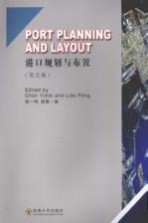图书介绍
港口规划与布置 英文版教材PDF|Epub|txt|kindle电子书版本网盘下载

- 陈一梅,廖鹏编著 著
- 出版社: 南京:东南大学出版社
- ISBN:9787564118969
- 出版时间:2009
- 标注页数:214页
- 文件大小:19MB
- 文件页数:223页
- 主题词:港口-规划-教材-英文
PDF下载
下载说明
港口规划与布置 英文版教材PDF格式电子书版下载
下载的文件为RAR压缩包。需要使用解压软件进行解压得到PDF格式图书。建议使用BT下载工具Free Download Manager进行下载,简称FDM(免费,没有广告,支持多平台)。本站资源全部打包为BT种子。所以需要使用专业的BT下载软件进行下载。如BitComet qBittorrent uTorrent等BT下载工具。迅雷目前由于本站不是热门资源。不推荐使用!后期资源热门了。安装了迅雷也可以迅雷进行下载!
(文件页数 要大于 标注页数,上中下等多册电子书除外)
注意:本站所有压缩包均有解压码: 点击下载压缩包解压工具
图书目录
1 INTRODUCTION1
1.1 The important role of modern ports1
1.2 Port and its main components2
1.3 Functions of modern ports4
1.4 Classification of Ports4
1.5 General information on port development6
2 PORT OPERATION AND SHIPS9
2.1 Cargoes9
2.1.1 Classification of cargoes9
2.1.2 Workings of cargoes inside the ports11
2 2 Port hinterland and port throughput12
2.2.1 Port hinterland and foreland12
2.2.2 Port throughput15
2 3 Forecast of port throughput18
2.3.1 Introduction18
2.3.2 Delphi Forecasting20
2.3.3 Time series forecasting22
2.3.4 Grey Prediction25
2.4 Ships27
2.4.1 Introduction27
2.4.2 Shipboard measurement28
2.4.3 Ship types30
2.4.4 The development of maritime ship36
2.4.5 Shipping services and networks38
3 INVESTIGATION AND ANALYSIS FOR PORT PLANNING40
3.1 Meteorological conditions40
3.1.1 Wind40
3.1.2 Rain and Fog42
3.1.3 Ice43
3.2 Oceanographic conditions44
3.2.1 Tide44
3.2.2 Waves45
3.2.3 Currents49
3.3 Estuary conditions51
4 TERMINAL AND LAYOUT OF QUAYSIDE53
4.1 Classification of terminals53
4.1.1 By the function53
4.1.2 By the layout54
4.2 Scale of terminals57
4.3 Determination of the optimum berth number62
4.3.1 The calculation of optimum berth number63
4.3.2 The application of queuing theory64
4.4 Some suggestions for port operation management70
4.4.1 Berth group70
4.4.2 Handling productivity71
4.4.3 The timing for increasing port capacity72
4.5 Determination of berth scale73
4.6 Typical layout for general cargo terminal74
4.7 Typical layout for container terminal77
4.7.1 Layout for container terminal water area77
4.7.2 Layout for container terminal land area78
4.8 Typical layout for dry bulk terminal84
4.9 Typical layout for Ro/Ro berth87
4.10 Typical layout for oil terminal92
4.11 Typical layout for LPG/LNG terminal94
4.12 Determination of berth surface elevation97
5 HARBOR AND BREAKWATER99
5.1 Introduction99
5.2 Water depth99
5.2.1 Components of water depth clearance and determinants100
5.2.2 Water depth in berthing area102
5.2.3 Water depth in approach channel103
5.3 Channels104
5.3.1 Channel Alignment104
5.3.2 Channel width105
5.4 Anchorage area and turning area107
5.5 Standards for harbor tranquility108
5.6 Layout of breakwater110
5.7 Aids to navigation113
6 LANDSIDE FACILITIES114
6.1 Port railway114
6.2 Road118
6.3 Other facilities of port120
7 PORT DEVELOPMENT PLANNING124
7.1 Port planning process124
7.1.1 Primary planning124
7.1.2 The port distribution planning126
7.1.3 The general port planning126
7.1.4 The port area planning127
7.2 Port demand forecasting128
7.3 Port site selection132
7.3.1 The port location132
7.3.2 The basic types of the port arrangement133
7.3.3 The basic requirement for the port site selection135
7.3.4 The port area and the urban area136
7.4 Port zoning138
7.4.1 Port zoning strategy139
7.4.2 Port zoning procedure141
7.5 Port financial evaluation142
8 PORT ENVIRONMENT ASSESSMENT AND PROTECTION147
8.1 General introduction147
8.2 Port environmental impact assessment148
8.2.1 EIA of port construction projects148
8.2.2 Environmental impact assessment of port planning150
8.3 Environmental protection of domain coast152
8.3.1 Domain coast environmental protection152
8.3.2 Ecological environment protection154
9 CHARACTERISTICS OF INLAND RIVER PORTS156
9.1 Introduction156
9.2 Site selection157
9.3 Terminals facilities161
9.4 Layout of Inland River Port165
9.4.1 Terminal surface and bottom elevation166
9.4.2 Layout of the berth line167
Appendix A Introduction to EDI169
Appendix B A Note on Queuing Theory176
Appendix C Logistics and Route Selection184
Appendix D Vessel Arrival and Berthing Time Distribution189
Appendix E National Plan for Coastal Port192
Appendix F Port of New York and New Jersey198
Appendix G Special Economic Zone,Free Trade Zone and Free Port204
References213